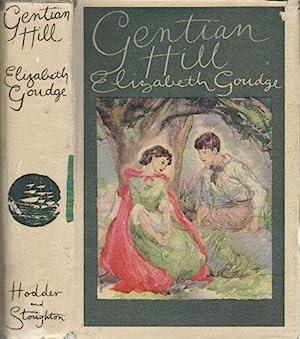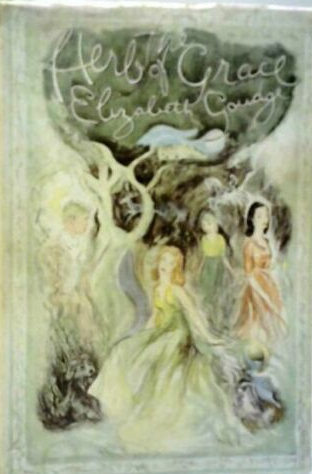Gentian Hill reviewed by Alison: The two novels Mary and I read would seem very different. The one I read, Gentian Hill, is an historical novel set at the beginning of the nineteenth century while Mary’s choice, The Herb of Grace, was a contemporary novel set in the post war period in which it was written. Yet, as we discussed them Mary and I were struck how closely they echo each other.
I was drawn to read this book because I recall reading during the early 1970s a copy of The Dean’s Watch by Elizabeth Goudge borrowed from the school library. Clearly, Elizabeth Goudge was considered suitable reading for teenage girls at that time, but I did not read any more then.

An historical romance, set in the era of the Napoleonic Wars, Gentian Hill is principally based in Devon, with additional episodes set aboard ship in the Mediterranean, and in London. Both the young people who inevitably and eventually become lovers and marry, are separated from their birth families. Stella was fostered by a childless farmer and his wife as a two-year-old when she was rescued from a ship which had blown up in Plymouth Sound. Anthony O’Connell joins the Royal Navy on the advice of an older cousin following the death of his grandmother who has cared for him since he was a baby. He is unprepared and ill-suited to the brutality and hardship of life as a young midshipman on a frigate, and deserts when his ship is approaching Torquay, not far from the farm where Stella lives.
The book is well structured, and whilst the actual narrative is pretty much predictable from close to the beginning, there are clear themes running through it which contribute to its interest. Firstly, the author demonstrates a real appreciation of the countryside, with many detailed and lyrical descriptions of the landscape suggesting a genuine knowledge and affection for the area. Elizabeth Goudge did live for a while in Devon. An example of this is her description of a local view which Stella sees as she is escorted by a farm hand to the local doctor who acts as her tutor.
To their right they looked through a break in the hills across a wide landscape of woods and fields to the splendid rampart of the moors rising against the western sky, while to the east, seen through another break in the hills, was the sea. The colours, the turquoise of the sea, the buff and emerald of the harvest fields and meadows, the green and gold of the woods and copses, the purple and russet of the moors, the clear blue dome of the sky, glowed through the silver haze of autumn sunlight like the colours of an opal, vivid and warm yet so soft that one felt invigorated and yet stilled at the same time.
Christian values are integral to the book and frequently extolled. This is once again a reflection of Elizabeth Goudge’s own life experience and belief system – her father was an Anglican priest and academic. Stella’s foster father, the farmer, reads the bible aloud to the household every evening, and one reading ends with the line from the bible, “The eternal God is thy refuge, and underneath are the everlasting arms.” Stella is very reassured by this, and the author states,
The whole universe, the living and the dead, those who dwelt in the lighted places and those in the dark outside, became to her no longer separate entities but one small thing, that round small thing up there in the air, no bigger than a hazel nut but bright as a diamond; and it was held securely in the hand of God, who for its very preciousness would not let it fall.
Elizabeth Goudge refers frequently to the co-existence of folklore and organised religion within the rural community, with the story slipping into the form of a fairy tale at times. For example, both the village church service and the visit of the Mummers on Christmas Day are described. The Abbé reflects on the Mummers’ play, “What you said was true” . . . “In the deep heart of this country the fairy world is still extraordinarily near the surface”. Zachary (as Anthony renames himself), the young hero, has a dreamlike, or perhaps mystical, experience associated with a yew tree, an important symbol in myths and legend.
Finally, and this made me feel uncomfortable, there are repeated assertions that people born into aristocratic families are in some way inherently and recognisably more refined in every way and superior to lower classes whatever their upbringing. A clear example of this attitude is embodied in the episode where Stella and Anthony/Zachary first meet, and Stella brings food for him. Anthony is described as being well mannered and aristocratic in his features despite his dirty and scruffy appearance, whilst Stella is described as
completely at ease with him. She felt, for the first time in her life, a sense of likeness with another human creature, and a sense of safety; not so much physical safety as the safety of understanding that comes between those who are two of a sort. Though she loved Father and Mother Sprigg so deeply she had never felt with them this particular feeling of safety. The gulf that yawned between her and the village children was only a crack between her and Father and Mother Sprigg, but it was there. Between her and this boy it was not there.
This really felt to me to like a justification for eugenics at times, but I found its inclusion puzzling. I speculate whether Goudge herself believed in this, but then so much else that she writes demonstrates a real sense of her humane attitude to others. Maybe, she included it because she thought it gave historical authenticity to her novel, but the Napoleonic Wars took place in the fairly early 19th century, whereas the interest in eugenics in England developed with Galton etc. later. Or perhaps my contemporary perspective gives it a significance she did not intend.
The Herb of Grace reviewed by Mary:
Written two years earlier than Gentian Hill, The Herb of Grace (1948) has many of the characteristics of the novel Alison discusses. Both have little emphasis on plot and more on spiritual growth. I share Alison’s uneasiness about Goudge’s attitudes to class and hereditary identity but the author’s version of Christianity in The Herb of Grace seems more peculiar and more unpleasant than the way Christianity is represented in in Gentian Hill.
Like Alison, I came across Goudge when I was a young teenager. The Little White Horse (1946) is an epiphanic and lyrical historical novel with a Christian theme of redemption and self-sacrifice. The little white horse was a unicorn. I reread the book constantly, as did J. Rowling who describes it as her favorite childhood book.

When reading The Herb of Grace, I recognised the same kind of ecstatic evocation of the ‘deep’ countryside I remember from The Little White Horse. Not only does the Kentish countryside pulse in the same way (semi-miraculously the woodland plants flower unseasonally in the depths of winter) but a white beast makes a redemptive appearance here too when a medieval fresco is discovered in the old Pilgrim Inn, now named the Herb of Grace. At its center is the ‘great immobile figure of the deer, white and shining holding the crucifix aloft between its antlers’. Such symbolism suffuses the novel and builds up a sense of anticipated epiphany on every page.
This mysticism sits alongside a much less thrilling evocation of the spiritual life in the uses the central figure makes of her Christian faith. Lucilla, the grandmother and guardian of many of the family members, epitomises the virtues both of the landed gentry and a kind of Anglicanism combined with a morally justified Machiavellianism.
The home that Lucilla has created is haven for all her displaced, lonely and unhappy relatives. The way she lives is admired by all, maintaining as she does the long-established way of life that the war had threatened to annihilate.
Great cities had been wiped off the face of the earth, but in the Damesrosehay drawing-room not a single ornament had suffered a change of position.
Her maintenance of the culture of her ancestors is illustrated in the way she maintains her habit of dressing for dinner and then when she gets to the dinner table, the way she tackles the substandard substitutes for the wholesome and fresh food to which she had been accustomed. In postwar Kent she sits down, not to Dover sole but to tinned sardines, not creamed potatoes but Bengers (a mixture of wheat-flour and an extract continuing the digestive ferments of the pancreatic juice). Lucilla’s sophisticated and wayward daughter-in-law, Nadine, chokes down ‘hysterical’ laughter at ‘The massive silver on the table, the lighted candles and the flowers, the beautiful china, Grandmother’s toilet . . . And Bengers and sardines’.
But despite her sense that Lucilla’s way-of-life is outdated it is Nadine who is outmanoevred by the older woman whose confidence in her own judgment is much greater than hers. Lucilla plots how to separate Nadine from the man she loves and to manipulate her into reconnecting with her own son, the unromantic George. First, Lucilla says her prayers, then dresses for her ‘Bengers and sardines’. As she does so she ruminates on the half-truths and downright lies she was peddling to her daughter-in-law, concluding that they were morally justified. ‘It was not really right to do evil that good might come, though so often, in dealing with daughter-in-law, it seemed that one had to.’ Succumbing to her mother-in-law’s designs Nadine breaks with the man she loves and reconciles herself to fidelity to her lumpy husband. The reader is persuaded this will work out well because as Nadine’s rival the innocent but insightful young Sally has perceived ‘It was one of the glorious things about life, that for the pliant there was never really any lasting emptiness.’
The book is full of such pronouncements and they make up a curious mix of interesting contradictions. On the one hand it presents as admirable the role of women to put up with men who are emotionally clumsier and more passive than they are. On the other hand the manipulative grandmother, the passionate Nadine and the young unmanipulative and unguarded Sally are presented as more resilient, attractive and vital than the men they are engaged in managing and reconciling themselves to. Goudge seems to me to be creating novels in that tradition described by Alison Light as ‘conservative femininity’, writing fictions which demonstrate the ruthlessness, resourcefulness and imagination of women whom the narrative dictates are actually as ‘pliant’ and as long-suffering as the heroines of much earlier fictions.
The way Christianity is represented is equally confused. The mysticism and visionary images of medieval Christianity combined with a kind of Nature worship that we find in The Wind in the Willows, is thrilling and vivid. But the Christianity practised by the devout grandmother is much more tarnished. Lucilla is a schemer who lives by the belief that the ends justify the means. To her everything must be forgiven, suggests the novel, because whatever it is she represents will redeem her shattered family. Nadine, the daughter-in-law she outwits recognises that
Lucilla’s efforts at preservation . . . [was] not so much the salvage of useless trash from a lost past, but paving-stones set upon the quagmire of these times, leading to a new dignity whose shape she could not guess at yet.
